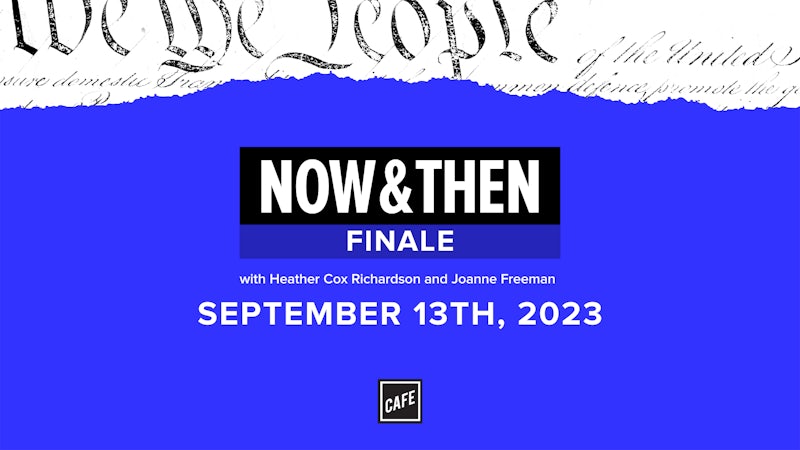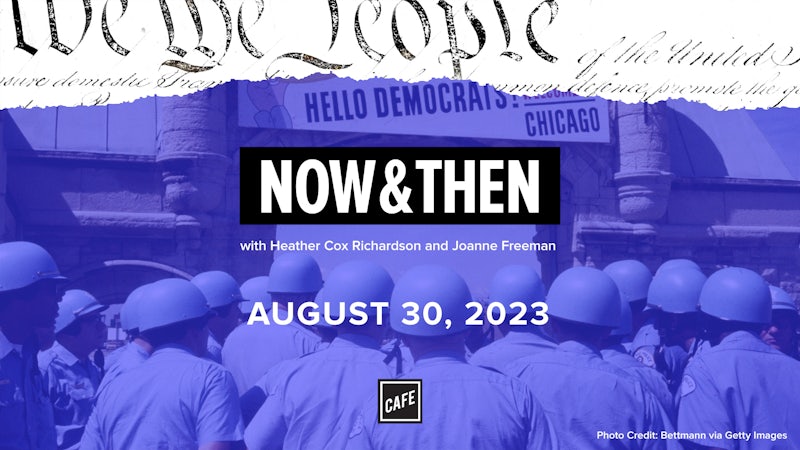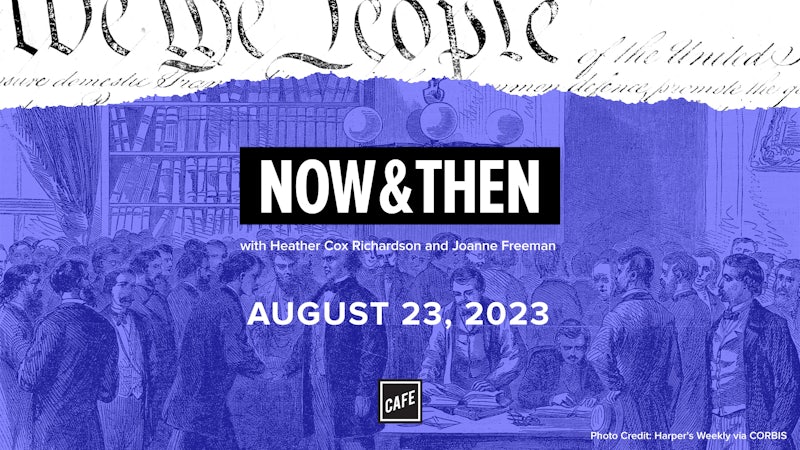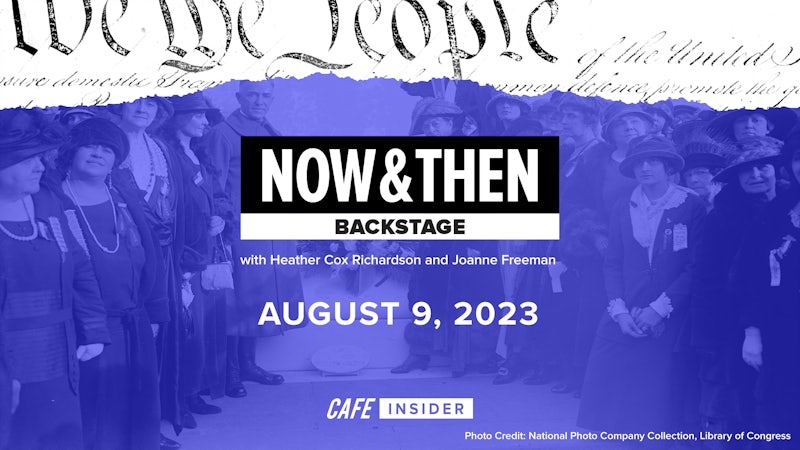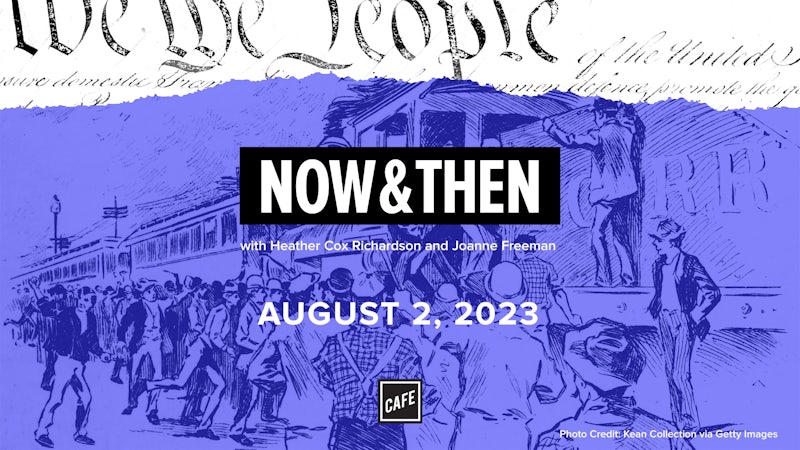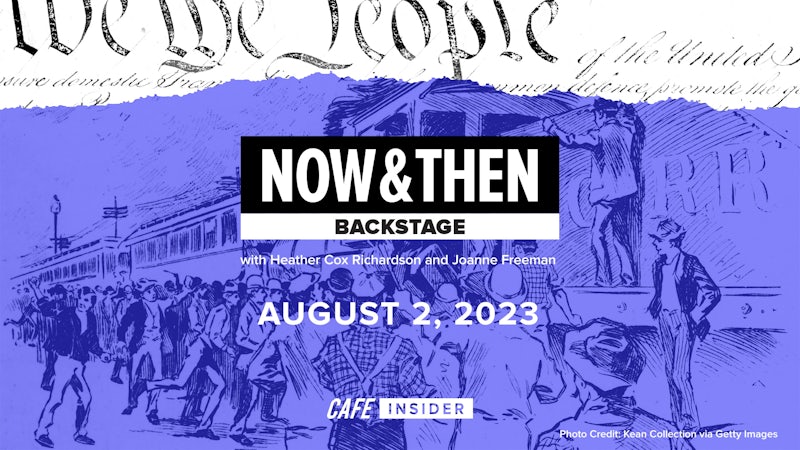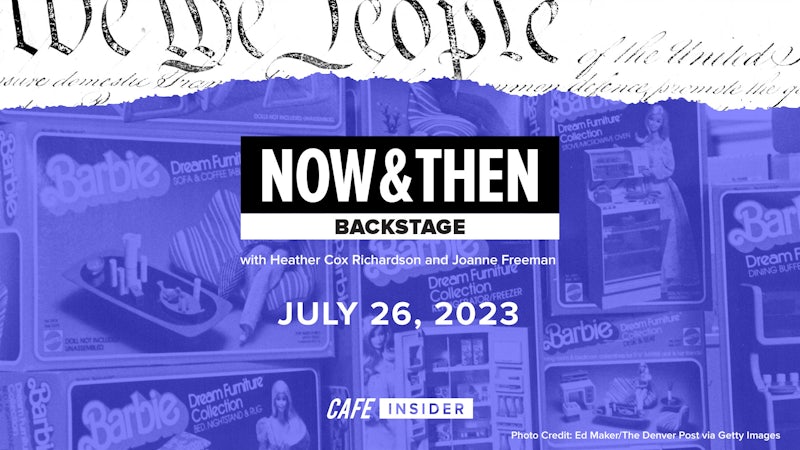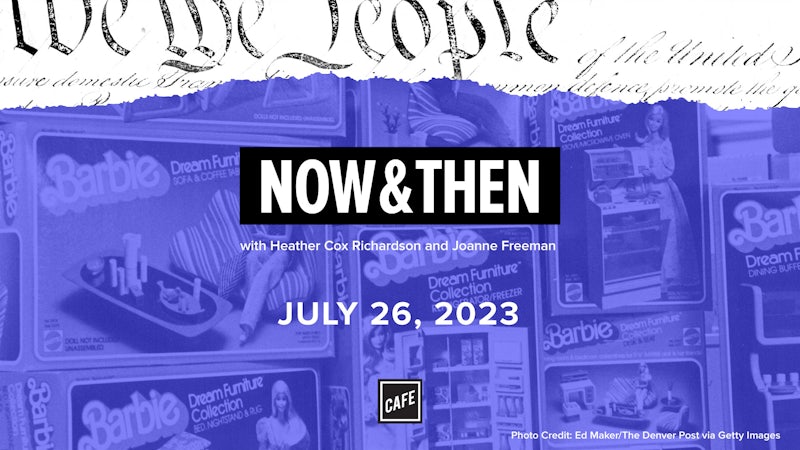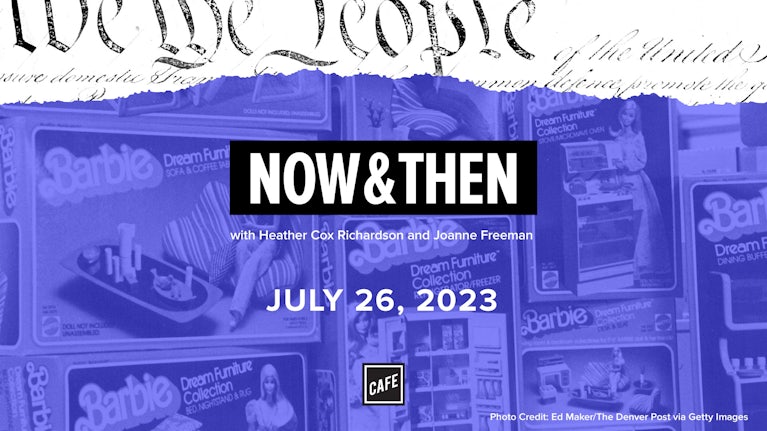Heather Cox Richardson:
From CAFE and the Vox Media Podcast Network, this is Now & Then. I’m Heather Cox Richardson.
Joanne Freeman:
And I’m Joanne Freeman. Today, we’re going to talk to you about debt, indebtedness, citizen indebtedness, which in one way or another, we’re bringing to you because, obviously, of President Biden’s student loan forgiveness plan that was released last week. Now, on August 24th, President Biden announced that he would basically wipe out $10,000 in student loan debt for those earning less than $125,000 per year and $20,000 for those who had received Pell Grants, for low income families. And there’s been a rather, what do I want to call it? Lively debate.
I don’t know if I’d even call it a debate. Conversation about what this means, with people on the left saying that this is something that’s going to enable people to pull themselves up from problems that they had, economic problems from the pandemic, and that it would give people an opportunity to better themselves, and people on the right talking about how this was sort of a free gift to people who, according to some on the right, don’t deserve it. So what we thought we would talk about today really is what’s the context for not only the plan, but for feelings about indebtedness, and what should be done to those who are in debt.
Heather Cox Richardson:
Interestingly, when we think about student debt, we talk about, for example, the fact that prices of education have skyrocketed since the 1980s, at the same time that loans have become available, so we ended up with a model that was both high tuition and high loan base. So we talk about educational policy and we’ve talked about how in the system we have now, what we’ve essentially done is we have offloaded the idea of educational funding onto individual borrowers. So we’re talking about educational policy and the legal structure of borrowing without really talking about these concepts as debt and what that means for individuals and for a society. So it’s a little bit of a different lens, and I think one that has actually made me really rethink the way I’ve thought, not homely about student debt, at the end of the day, but also at many of the different kind of debts we bear.
Joanne Freeman:
Absolutely. And the thing that I found myself thinking about in preparing for this episode, in some ways, debt has a moral component, and obviously it also has a market component. And the question is, what does debt mean? Is there a value associated with it? Should there be a value associated with it? Or to what extent is it really just a question of buying and selling, loaning and receiving? I don’t know, but the moral component of it is something that I find interesting historically, and interesting in the present moment, because a lot of the criticism of the plan really has that moral kind of an edge to it.
Heather Cox Richardson:
It. Oh, totally. And it’s so funny, and I guess not a surprise that we’re thinking about this the same way. The idea of a moral component to debt brings us to this really interesting foundation of the way Americans thought about debt in your period of time. And this seems to me to be just so incredibly alien. I’d love to hear you talk about what debt looked like in the early republic.
Joanne Freeman:
Well, I’ve always found this really interesting too, and I never really had a reason to plunge in any way until this episode. But the fact of the matter is, and this wasn’t only true in the early republic or the new government, like new country under the constitution. It went back through colonial times and was true also in England before. And that is when you went into debt, you were imprisoned. You were put in debtor’s prison. And there were people who were in debtor’s prison for very small amounts of money that they couldn’t pay back. And not everyone in debtor’s prison was poor. There were elite and wealthy people who ended up in debtor’s prison as well. When you were there, you were responsible for paying your own room and board, for your own food and anything else, I suppose, candles and whatever else you needed.
And part of the idea behind debtor’s prison was to make it so that number one, you really didn’t want to go there, because it’s not like there’s a term limit. You go into debtor’s prison and there you are until either you find a way to pay your debt or your friends come over and help you pay that debt, but there you are. So the threat of debtor’s prison is supposed to be one of the things that’s going to make you really not want to be there. In New York city, which was really renowned for its debtor’s prison, apparently in the 1780s and 1790s, I suppose this is really a image of American society at the time, there were three floors in the building that served as the debtor’s prison. And the top two floors had more elite people, and the bottom floor was essentially, I guess, the equivalent of steerage on an ocean liner. It was where the poorer people went. So the people up on the top could get visitors, could do things to try and, if they could, depending on their livelihood, do things to try and remove or lessen their debt.
Heather Cox Richardson:
Can I ask you some questions about this? I actually have a lot of questions you’ll be shocked to hear. So first of all, who gets the money? If my friends cough up three shellings, does that go to the person I took the chicken from or does that go to the state?
Joanne Freeman:
No, that goes to the person who you took the chicken from and didn’t pay for it. And that’s why one way in which you can get out of debtor’s prison is if the person you owe the money to ultimately says, “Okay, you served enough time. I give it. That’s fine. Keep the chicken. Don’t pay me back.”
Heather Cox Richardson:
That sounds really like it begs somebody to become a lone shark against your enemies.
Joanne Freeman:
If you think about it, you’re imprisoned, but the state isn’t paying for your provision or your board, and there’s no state determined length of time that you’re there. It’s weirdly personal, right? It depends on you personally and what you owe and what the person who gave you that money or who you owe the money to wants to do about it, and what your friends are willing to do. Are they willing to help you do whatever you have to do to pay off the debt? It could very conceivably be that you would be in debtor’s prison, and depending on what you did for a living, you might not have a way to make that money back.
Heather Cox Richardson:
So it’s really about society. So you don’t want to be humiliated by having to ask your brother to cough up the cash or whatever. But by the same token, it kind of makes the whole family responsible for my making off with a chicken.
Joanne Freeman:
No, absolutely. And so that not only is the person in debtor’s prison being looked at, but friends and family of that person are being looked at too. There’s supposed to be a humiliating aspect to it, enough that you wouldn’t want to end up there. And if you end up there, that you would really want to find a way out. And even in this early period, there was a society created called the society for the relief of distressed debtors, which was explicitly responding to the sorts of things you’re asking about, Heather, which is these people are in prison and they owe debt. And what are they going to do? And who’s going to help them? And how do they get out? It was seen as cruel in some ways, and I suppose in some ways, not edged in by rules.
Heather Cox Richardson:
I have another question. One of the things that has always interested me about the middle of the 19th century is that when they are talking about income taxes in the 1860s, the people discussing that on the floor of the Congress really just stand up and say, “We have no idea how much money we make. This person owes me this much money and this person owes me this much money, but I just got this huge check and I own this set of cattle.” And nothing is done by a yearly income. It’s really sort of, “Oh, I’ve got this coming in. I’ve got that going out.” And then they actually trade each other’s debt. “So I can’t pay you for this, but look, I’ve got a loan on Jack Wilson over there and you can have his debt.”
How often do you end up in debtor’s prison, or could you end up in debtor’s prison because people haven’t paid you? So you’ve behaved well, but you bought [inaudible 00:08:36] and… I’m having fun with this, by the way. I [inaudible 00:08:41] early republic house. And the people who were supposed to pay you for your farmstead, never pointed up the cash. So it’s not really your fault. It’s their fault. So do you throw them in prison first? I mean, how does this work?
Joanne Freeman:
I think if you take responsibility for a debt, you’ve taken responsibility for a debt. You’re signing your name to it, in a sense, then you’re taking that responsibility. If you’re going to use a debt as currency, and then the debt comes due and you can’t pay it, now it’s on you.
Heather Cox Richardson:
So this goes back to your mushroom gentleman you talked about, because that would mean that you wouldn’t ever want to sign for anything unless you were really sure the guy is going to put up the cash.
Joanne Freeman:
When there’s someone who wants to do business with someone else, often they’ll be a mutual friend who will write and say, “This is a gentleman you can trust. I’ve known this gentleman for X number of years. If you were going to engage in business with him in some way that involves trust and money and loaning, I would vouch for him.” I mean, personal reputation ends up being a big part of what’s going on here. And again, debtor’s prison is partly a stigma, I suppose, on your reputation until you can get out of there.
Heather Cox Richardson:
I’s like a credit score.
Joanne Freeman:
Sort of, except that if your friends come forward and pay, or if you find a way to pay, then you’re out, since debt is not exactly rare in this time, period. It’s not like you are standing out as this horrible, lone, evil person who owes money. It just means that you were in that prison. It was really not a nice place, although it’s nicer for you, if you were elite, and then you escape from it. So, I mean, that is important to note that there there’s a lot of debt in this time period, but still, the idea of being in prison with no particular term. It’s not like you owe this amount of money, and so you can be in prison for a year. You’re just there until something gets resolved. And what’s interesting to me, I mentioned a little earlier, there’s the society for the relief of distressed debtors, which is a kind of advocacy group that was created in New York in 1787, actually just before the constitution was drafted.
And one of the things that they did was try and figure out ways to help people in prison to pay off their debts. And a particularly famous example of this is there was a painter named Ralph Earl, and he was a trained painter. And at this point in early America, in 1780s, there aren’t that many well trained painters. American painters would go to Europe and train there, and then usually come back. So Earl is not like there they’re a dime a dozen. Earl was someone who was a professional portrait painter, and people knew that, but he was also, for two years, I believe, in debtor’s prison. And the society for the relief of distressed debtors apparently encouraged elite people, since Earl himself, he was a loyalist who fled to London, and then came back, so he himself is relatively elite.
The society encouraged elite people in New York to go sit for Earl in prison and have their portraits painted, which was very prestigious in this time period, and then pay Earl so he could come out. And there’s a famous portrait of Elizabeth Hamilton, Alexander Hamilton’s wife. You can’t tell from what’s behind her, that she’s sitting in a prison when it’s being painted, but she was.
Heather Cox Richardson:
She’s literally sitting in the prison. Yes,
Joanne Freeman:
Again, he was elite. He was probably on one of the sunnier, nicer top floors of this prison, but she went to see Ralph Earl in prison, sat for him in prison. He painted her portrait, made it all nice and gentile behind her, and then paid him. And apparently there were others who did the same, and Earl ultimately got out of debtor’s prison. Because people were sometimes there for the long term, and because they were there for failing to live up to something that they were supposed to do in society, in certainly the New York debtor’s prison, and I suspect other places as well, they created a little community within debtor’s prison. So very often, they would create their own constitution. They would have people who came in to the prison, sign onto it so that they would agree that they would be bound by whatever laws were in the constitution. In the New York prison, there actually even was a newspaper called, appropriately enough, The Forlorn Hope, which was published, written in prison and friends helped this person publish it out in public.
And part of the point was decrying the fate of debtors in prison. There was appointed officers in the prison. There were people responsible for watching that other people obeyed the laws of the prison. These aren’t official guards. These are indebted people who stepped forward and essentially created a kind of lawful society in debtors prison, which I find fascinating. It’s people in prison recreating the logic and order of the society that put them in prison. So it shows that they’re still totally sold on and participating in that same society. I just find that fascinating.
Heather Cox Richardson:
Or you could argue that they were afraid they’d never get back to that society so they were replicating it in their own sphere, which is much more reflective of English understanding of debt and of poverty. You couldn’t move up from poverty. Once you were there, you were stuck there forever. I do find the whole emphasis on morality and on individual bankruptcy as a moral issue really interesting, because as you started out by saying, debt is in this early period about morality, but at the same time, a society that is trying to expand economically needs to be able to leverage debt in order to make more capital available. So if you’re operating from the premise that going into debt is a moral failing and can land you in this purgatory that you can’t get out of because you’re stuck in this prison, who’s going to start borrowing to be an entrepreneur and to make a business grow. So we start to get this division between the morality of individual debt. Are you a good person or a bad person? Did you waste money on the finest wig or food?
Joanne Freeman:
You’re really into the [inaudible 00:15:02] , the wig. You’re in the moment, Heather,
Heather Cox Richardson:
Or are you a good debtor who has borrowed money to make a good idea happen and it just didn’t take off. In which case, that does not get defined as a moral failing. You can have a business fail in a way that you can’t have a household fail. One is a moral failing, and one is not.
Joanne Freeman:
One is, you could almost argue, an admirable risk. Certainly in the early United States, speculation, in positive and negative ways, is rampant, right? It’s new there’s land changing hand and new land opening up, and people are speculating on anything and everything in that time period. And so, in a sense, if you’re engaging in that kind of practice, you might make a lot of money, you might lose a lot of money. One could argue that certainly there’s something admirable to that, that you can’t put that kind of a stamp on someone who spends too much personally and goes into debt.
Heather Cox Richardson:
It is an interesting distinction though, that borrowing in a household economy, if you will, is a moral decision and borrowing in a market economy is something that’s good for the country. So in the one hand, we’re happy to chunk you into prison. And on the other hand, we want to make it possible for people to borrow like that without bearing undue penalties.:
In the 19th century, this concept that it’s a good thing to borrow for a business runs into the extraordinary expansion first of the early 19th century, and then to the period after the Civil War, because of course the Civil War really just jumpstarts the national economy. All of a sudden, they’re feeding the troops and they’re putting horseshoe on the mules and they’re mass producing guns and rain slickers and candy. And then after the war, railroads, and everything sort of gets jump started in a hurry. So you, first of all, want to be able to free up capital. You also want to be able to make sure people are willing to create these new businesses without fear. So one of the things that happens after the Civil War is a real change in the concept of incorporation and the idea of companies being able to incorporate and to raise money and to act as entities without having the personal individuals responsible for the debts of the company.
So they start to play around with, what is a public good? And we get the railroads. Is that a public good, or are they just there for money? And shortly after that, they’re going to stop worrying so much about public good, and just go for a whole new financing structure. It’s funny, these things seem like they shouldn’t be interesting. The divorce of people from having their own personal funds and reputations on the line with their companies is actually structurally really, really important. But then the other thing, of course, that happens is we get bankruptcy laws. And bankruptcy laws try to mediate, if you will, between the borrower who took risks and the lender, who’s like, “Whoa, doggies, pay me back,” and to make sure that you come up with a solution that is fairish to both of them. So the idea of bankruptcy legislation is to make sure there is a structured way in which a business can come apart, and perhaps even have a managed period of repaying debt rather than simply being like, “You suck, we’re throwing you in jail.”
And with luck, that should both give entrepreneurs more willingness to borrow, and it should make sure that lenders aren’t in real trouble in the risks that they’re taking.
Joanne Freeman:
Here’s my question about, again, post-Civil War versus pre-Civil War. So I know that there’s any number of financial panics in the decades before the Civil War. And sometimes, a year or two, three after a panic, there would be some kind of bankruptcy law that would arise, and then when things got more stable financially, it would be repealed. So 1837, there’s a panic. 1841, there’s some kind of bankruptcy law. Things get settled. 1843, the law is repealed. So that’s very specific. That’s not changing the nature of how people see debt. That’s like, “Ah, there’s a panic. People are in debt. We have to do something. Oh, they’re not in debt anymore. Okay. That’s the end of that.” So does the view of indebtedness as… You’re laughing at me.
Heather Cox Richardson:
That’s like Congress in a nutshell, right? “We’re panicked. We have to do something,” and then, “Oh, never mind. Everything’s good.”
Joanne Freeman:
No, exactly. Exactly. “Oh, it’s better now.” The end. So is there a way in which post-Civil war indebtedness and the way that the state deals with it changes?
Heather Cox Richardson:
I think that depends on who’s holding the debts and what the political moment is. So after the 1873 panic and the money downturns in the 1870s, for example, people were complaining that there shouldn’t be any kind of debt laws because, as the Sacramento Daily Union put it, “A rascally debtor could threaten his creditor with a recourse to the law, and that would enable him to walk away from the deaths that he had incurred.” The Sacramento Daily Union was very against the idea of people who didn’t have a lot of money having access to funds. And so, for example, it complained about post bankruptcy laws as being fraudulent, because remember, in this period, we have all sorts of fights over money, and over what money means, and over the fact that increasingly, capital is concentrated in the American east for weird reasons. And the west and farmers and entrepreneurs really want to access to capital, and they go into fairly heavy debt.
And then when you get a downturn, they freak out and say this wasn’t fair because of the way the system is structured. And so on those things, people take a political side. Either you want the bankruptcy legislation to protect the people who just got munched, or you don’t want it because you’re defending the creditors. But we end up getting a foundational bankruptcy law in 1898. And I think that’s a really significant law, because when they write that law, it’s written under the McKinley presidency. William McKinley was very much a representative of business interests, as was Congress at the time, and they wanted bankruptcy law to stop the booms and busts to make it possible for there to be a system whereby you could borrow money and you could have a hope to get paid without having to go through these sort of ratchets back and forth between the rights of the debtors and the rights of the lenders.
And when they signed the law in 1898 and act to establish a uniform system of bankruptcy, it was in fact supposed to be able to free up capital for entrepreneurship without taking out the personal aspect of that freeing up of debt in a way that it hadn’t been up until that point. But for me, the interest of that middle period is that we have the morality argument. And then we also have the idea that you want people to take on debt because it’s good for the economy, essentially. You just want to regulate it so it doesn’t become a moral issue in the streets, but that is a really interesting window into the idea of people borrowing for an education, because the idea of borrowing for an education intellectually looks as if it is an attempt to leverage debt for a public good, the same way you want entrepreneurs to say, “Yeah, I’ve got this great new whisk here. You want them to be able to…”
My 19th century household here. You want them to be able to get that money so that they can have the best new, whatever, and take it on the market. And if it doesn’t work well, oopsie poopsie. At least they tried.
Joanne Freeman:
Education loans is a way of, in one way or another, whoever’s providing the money, is investing in people to do something that ideally will better the larger good, or will better some good. It’s a different way of investing in society.
Heather Cox Richardson:
So it seems like those loans should be thought of in that sort of a way.
Joanne Freeman:
What’s interesting about this idea about where student loans come from is, in and of itself… It’s not as though there’s a sudden poof decision, “You know what? We need to invest in people so they can better society.” It’s partly prodded into place because in 1957, the Soviet Union launches the first artificial satellite Sputnik won. And that fact, that launch immediately in the United States raises questions about what the priorities are in the United States, how can they keep up with what’s going on in the Soviet Union? And thus, is there a way to invest in people and education that will enable the United States to keep up in that kind of technology space race?
Heather Cox Richardson:
I remember I used to teach at MIT, and my students loved Sputnik, not only for the technological aspect of it, but imagine what it was like to be an American in October of 1957. And the skies were still largely unreachable. Outer space was unreachable. And to know that the USSR had a little flying bit of metal up there, and you didn’t know what it was going to do. I mean, nobody really knew about those sorts of things then, and now we see satellites everywhere and it doesn’t seem like a big deal, but they’re like, imagine just being able to think, beep beep beep, and that made it alive.
Joanne Freeman:
Yeah, alive. And the implications of that, it’s not something you take for granted. So it’s like, wait a minute, the Soviet union has this thing up there, whatever it’s doing. And we don’t, and they do. I mean, you can also see how that would be intimidating, and potentially frightening as to what is being opened and what isn’t open at that point in time, seemingly, to the United States. So I find it fascinating that it’s that sensibility, that partly nervous, partly ambitious, partly competitive way of thinking about things brought the United States into really deliberately working towards student loans.
Heather Cox Richardson:
And it’s important that Eisenhower is an office at that time. And he had been the President of Columbia University, and he was very articulate about what it would mean to invest in education. And he was very clear that he was not only interested in scientists. He said-
Dwight D. Eisenhower (archival):
Young people now in college must be equipped to live in the age of intercontinental ballistic missiles. However, what will then be needed is not just engineers and scientists, even though these will be a vital importance. We must also have a people who will keep their heads, and in every field, leaders who can meet intricate human problems with wisdom and with courage. In short, we will need not only Einsteins and Steinmetzes, but Washingtons and Emersons.
Joanne Freeman:
That is so not of this moment, when we’re shooting down the humanities, that that’s not something worth investing in.
Heather Cox Richardson:
But see, this is one of the reasons that I’m a fan of Eisenhower. And I’m not by any means suggesting he did everything, but he had been trained not only in military tactics and all the things that one learned at West Point, but he also spent a year with a man who was determined to train him in the humanities, and he had this really broad view of leadership.
Joanne Freeman:
Leadership isn’t just technology. It’s people.
Heather Cox Richardson:
So when they decided to create a pathway to make it easier for people without a lot of money to go to college, they called it the national defense education act. I believe it was actually Eisenhower who established the department of health education, welfare, and the person in charge of the education is Elliot Richardson. But what I’m interested in here is that they’re arguing at first for both a need and a merit based scholarship program.
Joanne Freeman:
There is a debate at first, when this begins to be discussed, initially through the department of health education and welfare, about whether it should be a scholarship or a loan and what each means, what each has to do with merit, what each has to do with the values inherent in them. I mean, in and of itself, that’s fascinating, that they can generally agree that this is an investment that’s worthwhile, but how to invest that money and what that suggests about the investments and the people taking them is part of what’s being debated here.
Heather Cox Richardson:
So Eisenhower liked the idea of scholarships, made sense. If a good student wanted to be educated, it made sense for the government to invest in that student. And this, of course, is going to be before we have the real establishment of the well-funded public institutions in the 1960s. So he’s focusing on the individuals, and yet there was another serious body of lawmakers who did not want simply to hand money to people being educated. They wanted them to put skin in the game by asking them to take out a loan.
Joanne Freeman:
And the logic behind that is you can hear it in the words of Republican New York Representative Stuyvesant Wainwright. He likes the idea of loan system, and he says that a loan approach “Conforms to your philosophy of God helps those who help themselves. No give outs here. We’re not going to give out money. We’re going to give loans, and then the loans have to be paid back.
Heather Cox Richardson:
But doesn’t that sound just like borrowing for a corporation in the 19th century? You want to skin in the game. We want to make sure that you’re really going to be creating value for society with a loan. And logically, to me, if that’s the philosophy behind these, they should be structured in such a way that they can be forgiven in the same way that business loans could be forgiven in the 19th century, as opposed to the way that we talk about them nowadays, which is entirely in the first model you talked about, which is morality. Somehow you did something wrong by deciding you were going to invest in yourself and take a gamble on contributing to society in a way that is so monetarily valuable that you can pay this loan back. I mean, just to me, it doesn’t make logical sense. We’ve got morality. We’ve got the business model. Then we’ve got the concept of student loans that are based in what looks to me like the business model, but we’re judging them on the morality model.
And you know how I feel about things that look intellectually inconsistent. And maybe this goes back to the idea that you talked about, is when did we get bankruptcy legislation, firm bankruptcy legislation in the 19th century for businesses. And that is that with the expansion of these loans, higher education expands dramatically. And it not only expands into poorer white populations, but of course, into minority populations. And with that shift into minority populations, then we seem to be jumping back to the morality vision.
Joanne Freeman:
So, wait, are you saying that when things become more diverse, suddenly everybody’s focused on the morality of the people involved?
Heather Cox Richardson:
I actually think I would say it more strongly, that the idea that it’s great for people to invest in the economy and in themselves is just great, so long as they’re white, basically. And let me push that a little bit further, because with the rise of these loans, and then President Johnson’s higher education act of 1965, which dramatically expanded the loan program, it also dramatically expanded higher education. And that seems like it would be a societal good. By taking college access from about 3.6 million students in 1960 to 7.5 million, more than doubling it by 1970, you would think that we would think that was a good thing. And yet, of course, by the 1980s, there is a dramatic attempt to scale that back. The idea that we’re educating this many people in college is not a good thing, that rather than growing up to be a certain kind of American, they are challenging the status quo, and that is not a good thing. And so then somehow we get thrown back into the concept of morality.
Joanne Freeman:
Part of what we’re saying here over and over again is morality sort of looms, and then it gets pushed out of the way in favor of investment. And then the morality kind of looms again, and then it gets pushed out of the way in favor of investment, but that it’s never fully swept aside, that giving loans, citizen loans in some way, education or not, that there’s a moral component to them that is seemingly inescapable when it applies to an individual, not when it applies to a business.
Heather Cox Richardson:
See, I don’t think it’s inescapable though. That’s what I think what’s bothering me so much about this whole thing intellectually. It’s that we did the whole morality thing with the debtor’s prisons, and yet we decided as a country early on that, wasn’t a good way to make sure the country continued to grow, that we wanted to have a way to leverage debt in such a way that people could invest in businesses, in whatever. So then in the 1950s, someone says, “Hey, well, businesses are all great, but let’s really invest in what is the most valuable part of our society, which is our minds.” Then once we did that, and it really seemed to take off and seemed to work, the inclusion of all those minds in society suddenly threw us back to say, “This is all about morality, and having borrowed for this, you’re a bad person.”
Joanne Freeman:
In the 1950s and the 1960s, if you’re going to apply for a loan as a student, you have to swear actually two odes. One is to the constitution and the United States of America, and the second is that you are not involved with organizations that “teach the overthrow of the United States government by force or violence, or by any illegal or unconstitutional methods.” So they’re saying, “Okay, loans.” Right? “We’re not giving things away. We’re going to give money. It needs to be paid back. But as long as we’re doing that, if you’re going to get that kind of money, you have to swear an oath to your morality, to your values, to the fact that you’re going to support the government, that you’re not going to act against the government. And obviously, that’s going to be controversial. Why is that oath only happening for students? The morality component is a way of reigning in something that opens opportunity in one way or another, but it’s always sort of hovering there as a way to pull in or exclude people from the opportunity that kind of investment, that kind of money is empowering.
Heather Cox Richardson:
As I said, when we started this, illuminating that you really can’t think of debt in America without thinking about the way we have constructed a moral component around some of it and a market component around other of it. And when we focus on what is bad debt versus good debt and what that means for a society.
Joanne Freeman:
One of the things that I found interesting in looking at the debate over the olds, right? Because that becomes an issue at colleges and universities, that the students, if they want to get loans, are going to have to swear these odes. And not surprisingly, the Presidents of universities and of educational associations and academic associations B at that, why is that happening? Why are students being forced to do this? Why are they being asked to personally attest to their values in some way? That hardly seems fair?
Heather Cox Richardson:
Well, although that does speak back to what we started with, which is why education is good. Are we educating people to do things? Are we educating people to think broadly about issues? That’s sort of an educational policy tension that’s different than the debt tension.
Joanne Freeman:
Well, and that’s because education is the thing being invested in that sort of merges those things together. So supposedly, someone on the Vassar board of trustees at the time felt that the signing of the oath and the disclaimer were matters of individual conscience and that the college should protest the requirement, but should not deny the loans to students. So the oaths were what people were protesting, in one way or another. And some universities or colleges even said, “You know what? You need money applied to the university. We’re not going to go along with this program because those oaths are weird. They should be matters of individual conscience. Why are only students being asked to swear these oaths? Why is government, in one way or another, being enabled to interfere in educational institutions in this way?
What’s interesting about the current moment that we’re in, or one of the things when you’re talking about President Biden’s loan forgiveness plans for education is that yes, we’re talking about values and society and what we value, but we’re also talking about the morality and importance of education, and who should be educated and who shouldn’t be, and how do you get that education. And what does education mean? I mean, there’s so much bound up in this, and that’s true across time, but this argument in the 1950s and the 1960s about what does it mean morally for people to engage in this program, and should there be a moral component and should the state be involved in that, shows that same bundle of issues again and again and again, sort of coming back and bonding together and causing tensions.
So now, we’re at this moment. I read today that there are some on the right who are trying to figure out a way to launch an argument against President Biden’s loan forgiveness plan. And in part, they’re going to argue that economically it’s bad. And in part, I think they’re going to go in a direction that it’s, again, in some way, not preaching the right morals to give money that way, to basically just say, “Okay, we’re forgiving this debt.”
Heather Cox Richardson:
It’s not a small number of Americans affected, by the way. It’s 43 million Americans who have some federal student loan debt. And we’re a country of about 330 million people, many of whom never went to college, many of whom are too young to be in college. This is a lot of people. And the way we approach this debt says a lot about what we value.
Joanne Freeman:
What we value, who we are as a society, and who we want to be, what direction we’re going in is bound up with this as well. I mean, and in one way or another, that’s the common thread in everything that we’ve been talking about today, is these debates about loans, particularly citizen loans, are always about what citizens should be, who citizens should be, what opportunities they should have, and in what ways should the government be investing in them? Which is a very long way of saying… We’re talking about the building of society when we’re talking about loans, and that’s very blatantly true if you’re talking about education.













